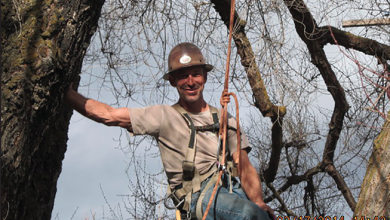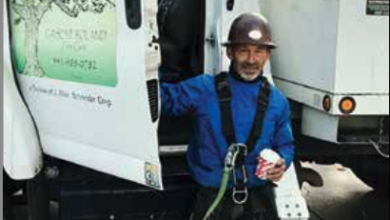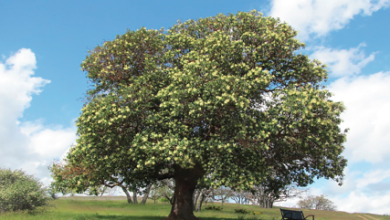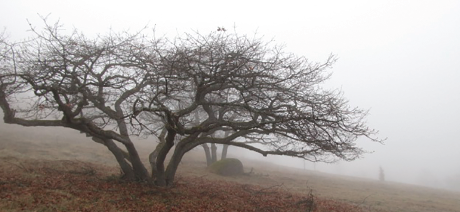Casey P. Roland Tree Care
The toughest part about Casey P. Roland’s job is not climbing to dizzying heights to care for majestic trees throughout Southern Oregon. These days, the hardest part for Casey is figuring out how to find enough hours in the day to schedule the long list of clients waiting to utilize Casey’s tree care services. Now in his 38th year of business Casey approaches each job as though it were his first. The passion he has for trees is unparalleled and his knowledge and expertise are rare. I met up with Casey to talk all about trees.
Casey, thanks and welcome back for another interview in the LocalsGuide. As part of our interview today I would like to re-introduce you to our community as a local Arborist Extraordinaire.
Thanks for having me! This is my eighth year here running (literally) my own business. The last three years were seven day work weeks for me, so my hobbies really took a back seat. Being a one man show with limited help pushes my schedule around quite a bit, but I am preparing to change up and delegate some of the work load by utilizing outside help such as subcontractors, but I will still be writing the specs on the job, and overseeing quality control.
Thirty eight years of climbing is a long time and I still love it, but there is only so much you can do in a day. With fire restrictions in the summer, in-climate weather, and short daylight hours in winter it can be a challenge to get everything finished.
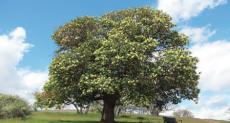 As part of your re-introduction to our community please tell us how you first got your start in the tree care business. How did you know this was your calling?
As part of your re-introduction to our community please tell us how you first got your start in the tree care business. How did you know this was your calling?
Well, I’m not sure it was actually my calling per se at the time, but it certainly was a way for me to get out of school and make a living. I took a job with a neighbor, as a teen, and ended up working for a contractor in Santa Rosa, CA who took trees out for PG & E. I was always pretty outdoorsy as a kid, but really had no idea that I would come to love it so much. I can’t imagine doing anything else with my life. Literally. Now all I see is trees. I’m not kidding.
So what is it about trees that keeps you loving your job?
Trees are the lungs of the earth, the union between the earth and the atmosphere, they create solar powered air conditioning, and in short, the main reason for our very existence. Every tree, even if they appear identical, is different in one way or another, good or bad, deciduous or evergreen, conifer or hardwood, short or tall. So every day is a learning experience for an open minded arborist. To me, being an arborist is the best job in the world and an honorable profession. I was very fortunate to have Joseph Schneider as my mentor, who founded Pacific Tree Care in the Napa Valley. Joe is by far the best tree guy in the world, without question. His insight and connection with trees is magical, my philosophy is based on his teachings, and I will be forever grateful for our friendship. He is one of the few people in the world I would let work on my own trees.
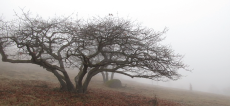 What is the biggest similarity and difference between trees and people?
What is the biggest similarity and difference between trees and people?
If you were to extract a tree’s chlorophyll in its elemental makeup and substitute the magnesium with iron, without changing any other component or ratio of the elemental makeup, you would have a red blood cell! In regards to differences trees are able to manufacture their own food and people are able to move away from danger. If only we could just switch things around a bit.
Tell us more about the difference between good tree care and bad tree care.
Really good tree work is nearly invisible and by that I mean you can tell something has been done, but you can’t quite put your finger on it. I enhance the tree’s good points, usually by eliminating the undesirable or unnecessary ones. Pruning tools aren’t paint brushes, more like erasers, and a skilled tree care professional with a good eye can edit the superfluous parts while leaving the functional, necessary, and esthetic aspects of the tree without altering the structure or form. It takes the same amount of time to make a correct cut as an incorrect cut, but that’s where intuition and expertise comes into play. I have found that good work sells itself. “Old School” tree work is just about dead, thank goodness! Modern arboriculture didn’t really hit the scene in the U.S. until the mid to late 70s and just blossomed from there. The great work by Dr. Alex Shigo, Rutherford Platt, James P. Jackson and other scientists who wrote the book on modern arboriculture deserve the credit for changing the way we look at trees. I urge my clients to read the works of these insightful arborists.
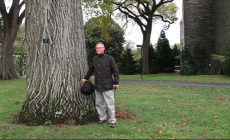 Please give us a brief overview of the services you provide.
Please give us a brief overview of the services you provide.
My service is first and foremost education. Understanding how a tree functions in its everyday life and passing that knowledge along to my client is the most valuable service I can provide, and I do that for free! I also offer pruning, restoration after improper “pruning”, planting and early care, structural enhancement (bolting and propping), removal, improvement of cultural conditions within the root zone, consultation, appropriate species selection, irrigation and fertilization guidelines, and protection before and during construction.
You love the work you do and it seems that your clients also love working with you. Please talk more about this.
I don’t B.S. my clients and I won’t compromise quality. I have dedicated my life to taking good care of trees, and I spend a fair amount of my time talking people out of unnecessary pruning jobs. I think people really appreciate my honesty. My greatest satisfaction comes from the opportunity to tell a potential customer that they should spend their money on a mini-vacation or a night out on the town with their significant other, and call me in a couple of years for an assessment. I just won’t sell a job that isn’t vital or needed, and I take a “less is more” attitude when I can. That approach has sold more work from word of mouth than anything else. So remember, if it’s not broken don’t fix it!
So, tell us about the topping of trees in Ashland, is it really illegal?
Thankfully, as with many cities around the country, it is a violation of local ordinance to “top” a tree. There are exceptions, such as eliminating interference with overhead electrical conductors, removing dead or structurally compromised portions of a tree, and fruit tree pruning of course. There is a really fine line between topping and “crown reduction” and can be a difficult call to make. There are standards set by various organizations with differing opinions, formulas, and ratios concerning the definition of “topping”. The city of Ashland has begun taking a more vigorous stance toward sub-standard work with fines and penalties, and rightly so! After all, we have a “Tree City U.S.A.” status to live up to, and who really wants to look at a bunch of hacked trees anyway? It is very easy to keep a big tree small, heck, even a deer can do it! However, it’s almost impossible to make a big tree small. The #1 reason why people top trees is because the tree, most of the time, will survive the calamity. Trees by their very nature are survivors, but a topped tree losses its dignity and its structural integrity will be compromised making for a potentially hazardous situation that is extremely difficult, if not impossible, to correct.
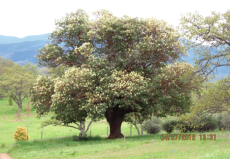 Casey, what are some of the things we have been taught to do with trees that we really shouldn’t do?
Casey, what are some of the things we have been taught to do with trees that we really shouldn’t do?
People tend to want to “fix” things. Back in the day, tree work consisted of strapping on a set of “hooks” (climbing spurs), stomping holes up the trunk to some predetermined height, whipping out the trusty chainsaw, and cutting off the top. We would then apply an asphalt based sealant in an attempt to combat the decay that was sure to flourish as a result of the cut. If the tree survived long enough to regenerate a new poorly formed crown, we would then install cables to hold the whole mess together. Yes, I cringe to think I was guilty of all of the above many years ago when I first started out. I didn’t know any better back then, but I have seen the error of my ways. I hope those trees can forgive me. Don’t even get me started on the practice of injecting trees with whatever the “flavor of the month” is!
Casey do you have any new techniques or tricks up your sleeve to share with our readers?
I have been taking good care of the above ground portions of trees for many years and have come to know that root care is just as, if not more, important regarding general tree health, and longevity. Over time, soils that have been irrigated regularly become compacted and leached. Urban trees can be subjected to some unfavorable soil conditions within the root zone, and I have the tools and techniques to reverse the negative impacts. Aeration, hydration, and inoculation are the buzzwords for the day, and most important for premium root health. My new slogan is, “We don’t get to the root of the problem, we get to the problem of the root!”
What types of results are you seeing with this technique?
The results can be dramatic for “unstressing” a tree impacted by unfavorable soil conditions.
Casey you are sort of a rock star columnist in the LocalsGuide. What has some of the recent feedback been from your readership?
I have people tell me all the time that they look forward to new articles in my column and it makes my head swell a little. I didn’t think anybody really read them! I think it is essential that people know as much as possible about proper tree care, and I try to share as much as I can. Looking back at the way arboriculture has changed in the last few years shows that we are learning as we go. Many skilled arborists took the time to show me the way, and I think I should do the right thing and pass along what I have learned.
In reflection to the columns you have written which ones have received the most acclaim?
The article on “topping” really stirred the pot! Amazingly the word hasn’t reached everybody on earth that butchering a tree is a crime against nature. I can’t really blame a tree owner that is unaware of what is, or isn’t, good practice as far as tree work goes, but every tree guy/gal worth a spit is VERY aware that “topping” amounts to nothing more than malpractice motivated by greed. We need to band together as a tree loving community and run the butchers out of town, lest we have to look at hacked trees on every corner!
What’s the best way for readers to get in touch with you Casey?
Phone me and keep calling – I can be hard to reach, but I look forward to hearing from you.
Casey anything else to mention before we sign off?
I am looking to put together a top notch crew, but I feel that keeping it small and personal is the best way. Providing the best care possible for trees is what I am all about, and I insist that everyone working on my (your) trees shares my passion. That said, I had the good fortune of learning from the best and I would like to pass that on.
Learn More:
Casey P. Roland Tree Care
541-488-0782

